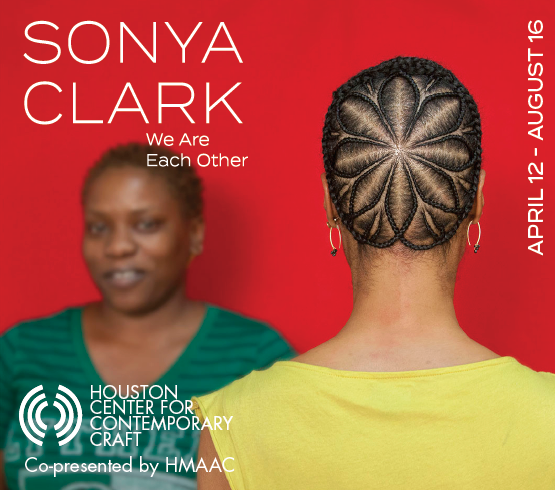“My pathology is your profit,” a banner reads. Hanging from the rafters of the Contemporary Art Museum Houston’s main gallery, the silvery background glimmers as the text picks up the purplish hue of the light.
Lined among a selection of other banners, the forms and phrases echo back the anxieties of a tumultuous year. Through her work, artist Cauleen Smith offers inoculations, reality checks, and hope when nihilists cast doubt upon utopia.
Smith continued, “The way a thing is taken apart significantly informs the way a new thing can be built.” In order to build a new system, it’s essential for people to imagine new possibilities.
On view through Oct. 3, 2021, the exhibition Cauleen Smith: We Already Have What We Need presents a collection of tools, imaginings, and prompts from the Los Angeles-based artist.
While the banners evoke images of protest signs, the artist’s vision for them expands to a litany of social rituals. “The most direct one would be the Requiem Mass—a procession to mourn the loss of dead souls,” she stated. “I am interested in all kinds of forms that galvanize large groups of disparate peoples.”
Protests are merely one among the multiple rituals Smith references in her work, with “…Requiem Masses and military processions and even masonic heraldry are directly referenced in the textile banners hanging in CAMH.”
Instead, Smith speaks to the redemptive, inspirational power art has over people. “Art has the ability to destabilize the feelings and beliefs of an individual in ways that allow them to create movements, change, or expansions in their own lives,” she added. So long as the work informs the way people move through the world, Smith seems sated with the influence.
“They may use these epiphanies to do political activism and that’s great, but they could also allow the experience of art to just help them move through the world a little differently, with more consideration for the unfamiliar and the unknown,” she said. “For me, that’s enough.”
It is through the multi-channel video installation, We Already Have What We Need, that we begin to see the blend of motion and imagination from Smith’s work. Large sails drape down from the ceiling of the gallery space. Projected onto them are still-lifes that remain less still and more undulating portals into different worlds.
Assorted objects occupy the landscapes projected onto these sails. They rest upon tables obscured momentarily by the fabric (in a true show that the means of production are readily available) and sit against monitors displaying footage sourced from short films crafted by the artist and found footage of seascapes and cosmological events.
In their own mesmerizing way, the projections show the relationship between us, our “stuff,” and the natural space we occupy. From there, Smith leaves the doors and windows open to allow our own dialogue to fill the air. Between our own musings and the history available, we have the means to pursue our own imaginings of utopia, harmony with the world, and care for others.

1 ⁄8
Installation view of Cauleen Smith: We Already Have What We Need, Contemporary Arts Museum Houston, Texas, 2021.
Photo by Sean Fleming.

2 ⁄8
Installation view of Cauleen Smith: We Already Have What We Need, Contemporary Arts Museum Houston, Texas, 2021.
Photo by Sean Fleming.

3 ⁄8
Installation view of Cauleen Smith: We Already Have What We Need, Contemporary Arts Museum Houston, Texas, 2021.
Photo by Sean Fleming.

4 ⁄8
Installation view of Cauleen Smith: We Already Have What We Need, Contemporary Arts Museum Houston, Texas, 2021.
Photo by Sean Fleming.

5 ⁄8
Installation view of Cauleen Smith: We Already Have What We Need, Contemporary Arts Museum Houston, Texas, 2021.
Photo by Sean Fleming.

6 ⁄8
Installation view of Cauleen Smith: We Already Have What We Need, Contemporary Arts Museum Houston, Texas, 2021.
Photo by Sean Fleming.

7 ⁄8
Installation view of Cauleen Smith: We Already Have What We Need, Contemporary Arts Museum Houston, Texas, 2021.
Photo by Sean Fleming.

8 ⁄8
Installation view of Cauleen Smith: We Already Have What We Need, Contemporary Arts Museum Houston, Texas, 2021.
Photo by Sean Fleming.
Recalling that plenty of people occupied the planet for millennia and managed to live in harmony with the planet, she continued: “Because of this fact,” she said, “my work does not have to be an instruction manual for fixing stuff.”
Instead, Smith provides viewers with the means to re-orient themselves and gain perspective on the experience of their own human essence. In speaking to this reorientation, Smith referenced the idea of humans destroying the planet as merely one interpretation.
To this end, Smith continues her reorientation to say that as humans occupy the planet, it’s essential to adjust our views. While the planet does not need us, we do, in fact, need the planet—despite the recent interest among billionaires to explore space as a hobby.
Smith’s suggestion to humanity is that we “understand the relative scale of their activities and re-invert them back to a rational and sane empirical relationship.” As we resituate ourselves on the planet, perhaps then we can begin to appreciate where we are and how to build a better future collectively. “The base fact of the matter is that the planet earth is our spaceship,” Smith stated. “We should behave accordingly.”
-MICHAEL McFADDEN




